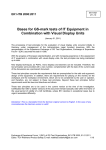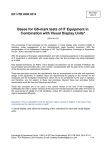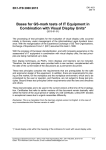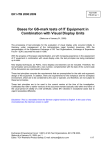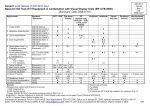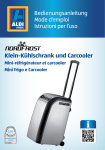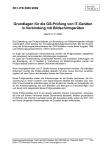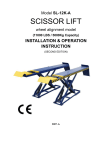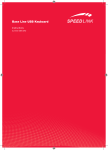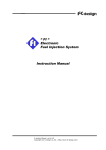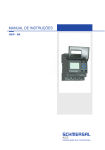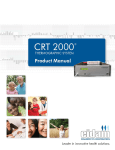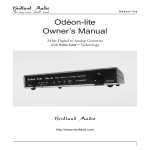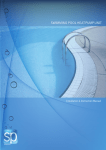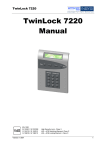Download EK1-ITB 2000:2012
Transcript
EK1-AG1 223-11 EK1-ITB 2000:2012 Bases for GS-mark tests of IT Equipment in Combination with Visual Display Units (January 01, 2012) The processing of test principles for the evaluation of visual display units occurred initially in Germany under management of the Administrative Legal Accident Insurance. With the reorganization of the Experience Exchange of GS Test Organizations, Exchange of Experience Forum 1 (EK1) assumed this task in 1998. With the progress of European standardization, and with increasing experience in the assessment of IT equipment in combination with visual display units, the test principles are being maintained up to date. New display techniques, as PDA's, micro displays and beamers can be included. Therefore, the test principles were provided with a new number, complemented with the date of the current state of the discussions as a permanent document. These test principles comprise the requirements that are prerequisites for the safe and ergonomic design of the equipment. In addition, there are requirements for placing on the market, for the workplace and the workplace environment, which are to be considered by the user or operator, and therefore, are not subject to these test principles. Beyond these test principles further requirements exist like laws and directives and others. These test principles are to be used in the current version at the time of the investigation. Certificates that refer to earlier versions of this document remain basically valid within the frame of the usual period of validity of a GS Certificate, unless EK1 decides in exceptional cases due to urgent necessities differently. Disclaimer: This is a translation from the German original version to English. In the case of any inconsistencies the German version is valid! Exchange of Experience Forum 1 (EK1) of GS Test Organizations, EK1-ITB 2000, 01.01.2012 Editor: TÜV Rheinland Product Safety; E-mail: [email protected] 1/16 EK1-ITB 2000:2012 A.1 General Principles A.1.1 Guidelines and Laws 2006/95/EC Directive 2006/95/EC of the European Parliament and of the Council of 12 December 2006 on the harmonisation of the laws of Member States relating to electrical equipment designed for use within certain voltage limits (codified version). 89/336/EEC Council Directive of 3 May 1989 on the approximation of the laws of the Member States relating to electromagnetic compatibility, implemented in Germany by the Electromagnetic Compatibility of Equipment Act. (replaced by 2004/108/EC) 2004/108/EC Directive of the European Parliament and of the Council of 15 December 2004 on the approximation of the laws of the Member States relating to electromagnetic compatibility and repealing Directive 89/336/EEC. 90/270/EEC Council Directive of 29 May 1990 on the minimum requirements concerning the safety and health protection during work on visual display units (Individual Directive in the context of Article 16, Clause 1 of Directive 89/391/EEC), implemented in Germany by the Ordinance on Visual Display Units (Occupational Safety Law, 19. December 1998 version). 93/68/EEC Council Directive of 22 July 1993 on the amendment of the above-mentioned Directives. 2006/42/EC Directive of the European Parliament and of the Council of 17. May 2006 on machinery, and amending Directive 95/16/EC (recast) 98/37/EC Council Directive of 22 June 1998 on the approximation of the laws of the Member States relating to machinery, implemented in Germany by the ninth ordinance to the Technical Plant and Equipment Act. 2001/95/EC Directive of the European Parliament and of the Council of 3. December 2001 on general product safety. German Product Safety law (ProdSG) law on the provision of products on the market, December 1, 2011 Exchange of Experience Forum 1 (EK1) of GS Test Organizations, EK1-ITB 2000, 01.01.2012 Editor: TÜV Rheinland Product Safety; E-mail: [email protected] 2/16 EK1-ITB 2000:2012 German Product Safety & liability law (GPSG) dated January 6, 2004 including therein named changes of ordinances of the overrulled GSG (Product Safety Law). Electromagnetic Compatibility of Equipment Act (EMVG), 18. September 1998 version. (not in force) Electromagnetic Compatibility of Equipment Act (EMVG), 26.02.2008. Ordinance on occupational safety and health protection during work with visual displays (Bildschirmarbeitsverordnung - BildscharbV), 04. December 1996 version. Ordinance on the protection against injury by X-ray radiation (X-ray Ordinance RöV), 08 January 1987 version. R&TTE directive 1999/5/EC Directive on radio equipment and telecommunications terminal equipment and the mutual recognition of their conformity A.1.2 Test and Evaluation Considerations The manufacturer defines the intended context of use of the equipment. If necessary, he has to determine any special environmental conditions in the Instructions for Use. These declarations are to be considered during the test and are to be repeated in the certificate. In particular, restrictive declarations of the manufacturer in his product description must also be documented in the certificate. Information necessary for installation, startup procedure and safe use must accompany the product in writing (German language). Broader information may be contained on data storage devices (CD, floppy disk). The existing test principles are binding on all GS test- and certification bodies and are to be considered by market surveillance authorities in Germany too. If the requirements of the applicable standards are not specific, the Essential Requirements of the Directives or the protection objectives of the Standards are to be interpreted by the experts accordingly. Exchange of Experience Forum 1 (EK1) of GS Test Organizations, EK1-ITB 2000, 01.01.2012 Editor: TÜV Rheinland Product Safety; E-mail: [email protected] 3/16 EK1-ITB 2000:2012 A.2 Standards for Product Safety A.2.1 Basic Standard DIN EN 60950-1 DIN EN 60065 Safety of information technology equipment Audio, visual and similar electronic apparatus - Safety requirements Additionally, the following standards may be applicable: A.2.2 A.2.3 Safety in General DIN EN ISO 12100-1 Safety of machinery; basic concepts, general principles for design; part 1: basic terminology, methodology DIN EN ISO 12100-2 Safety of machinery - Basic concepts, general principles for design - Part 2: Technical principles and specifications Electrical Safety DIN EN 60204 - 1 A.2.4 Safety of machinery - Electrical equipment of machines Part 1: General requirements Mechanical Safety DIN EN 294 DIN EN 349 Safety of machinery; safety distances to prevent danger zones from being reached by the upper limbs Safety of machinery; minimum gaps to avoid crushing of parts of the human body DIN EN 547 - 1 Safety of machinery - Human body measurements - Part 1: Principles for determining the dimensions required for openings for whole body access into machinery DIN EN 547 - 2 Safety of machinery - Human body measurements - Part 2: Principles for determining the dimensions required for access openings DIN EN 61310 part 1 Safety of machinery - Indication, marking and actuation Part 1: Requirements for visual, auditory and tactile signals DIN EN 61310 part 2 Safety of machinery - Indication, marking and actuation Part 2: Requirements for marking Exchange of Experience Forum 1 (EK1) of GS Test Organizations, EK1-ITB 2000, 01.01.2012 Editor: TÜV Rheinland Product Safety; E-mail: [email protected] 4/16 EK1-ITB 2000:2012 A.2.5 Safety concerning high temperature DIN EN 563 CEN guide 12 Safety of machinery - Temperatures of touchable surfaces - Ergonomics data to establish temperature limit values for hot surfaces (includes Corrigendum AC:1994 and Amendment A1:1999) Temperatures of surfaces likely to be touched Replaced by CENELEC Guide 29 A.2.6 A.2.7 A.2.8 Temperatures of hot surfaces likely to be touched Safety concerning noise DIN EN ISO 7779 Acoustics; measurement of airborne noise emitted by information technology and telecommunications equipment DIN EN 29295 Acoustics; measurement of high-frequency noise emitted by computer and business equipment (ISO 9295:1989); German version EN 29295:1991 ISO 9296 Acoustics; declared noise emission values of computer and business equipment DIN EN 50332-1 Sound system equipment: Headphones and earphones associated with portable audio equipment - Maximum sound pressure level measurement methodology and limit considerations - Part 1: General method for "one package equipment"; DIN EN 50332-2 Sound system equipment: Headphones and earphones associated with portable audio equipment - Maximum sound pressure level measurement methodology and limit considerations - Part 2: Matching of sets with headphones if either or both are offered separately Labelling and Information in Instructions for Use ISO/IEC 12119 Information technology - Software packages – Quality requirements and testing ISO/IEC Guide 37 Instructions for use of products of consumer interest DIN EN 62079 Preparation of instructions Structuring, content and presentation Ergonomic design For testing of the ergonomic design of a product in particular apply: Exchange of Experience Forum 1 (EK1) of GS Test Organizations, EK1-ITB 2000, 01.01.2012 Editor: TÜV Rheinland Product Safety; E-mail: [email protected] 5/16 EK1-ITB 2000:2012 DIN 2137 Part 1 Text and office systems - Keyboards - Part 1: German keyboard for typewriters; key arrangement and allocation of characters to keys DIN 2137 Part 2 Text and office systems - Keyboards - Part 2: German keyboard for data and text processing; key arrangement and allocation of graphic characters to keys DIN 2137 Part 6 Text and office systems - Keyboards - Part 6: German keyboard for data and text processing as well as for typewriters; key arrangement and allocation of functions to keys DIN 2137 Part 6, Annex 1 Text and office systems - Keyboards - Part 6: German keyboard for data and text processing as well as for typewriters; information on the symbols to be used to represent functions DIN 2137 Part 10 Text and office systems - Keyboards - Part 10: German keyboard for data and text processing as well as for typewriters; arrangement of key positions and key distances Text and office systems - Keyboards - Part 11: German keyboard for data and text processing as well as for typewriters; principles governing the allocation of graphic characters or of functions to keys and the placement of their symbols on the keys DIN 2137 Part 11 DIN 2137 Part 12 Text and office systems - Keyboards - Part 12: German keyboard for data and text processing; key arrangement and allocation for portable computers Annex 1 to DIN 2137 Text and office systems - Keyboards - German keyboard data and text processing as well as for typewriters; information on graphic keys and the allocation of graphic characters or symbols DIN EN ISO 9241-1 Ergonomic requirements for office work with visual display terminals (VDTs) - Part 1: General introduction (ISO 9241-1:1997); German version EN ISO 92411:1997 DIN EN 29241 - 2 Ergonomic requirements for office work with visual display terminals (VDTs); part 2: guidance on task requirements DIN EN 29241 - 3 Ergonomic requirements for office work with visual display terminals (VDTs); part 3: visual display requirements (replaced by ISO 9241-3xx) Exchange of Experience Forum 1 (EK1) of GS Test Organizations, EK1-ITB 2000, 01.01.2012 Editor: TÜV Rheinland Product Safety; E-mail: [email protected] 6/16 EK1-ITB 2000:2012 DIN EN ISO 9241-4 Ergonomic requirements for office work with visual display terminals (VDTs) - Part 4: Keyboard requirements for visual display terminals (ISO 9241-4:1998); German version EN ISO 9241-4:1998 DIN EN ISO 9241-6 Ergonomic requirements for office work with visual display terminals (VDTs) - Part 6: Guidance on the work environment DIN EN ISO 9241-7 Ergonomic requirements for office work with visual display terminals (VDTs) - Part 7: Requirements for display with reflections (ISO 9241-7:1998); German version EN ISO 9241-7:1998 (replaced by ISO 9241-3xx) DIN EN ISO 9241-8 Ergonomic requirements for office work with visual display terminals (VDTs) - Part 8: Requirements for displayed colours (ISO 9241-8:1997); German version EN ISO 9241-8:1997 (replaced by ISO 9241-3xx) (Draft standard) DIN EN ISO 9241-9, Publication date:1998-10 Ergonomic requirements for office work with visual display terminals (VDTs) - Part 9: Requirements for non-keyboard input devices (ISO/DIS 9241-9:1998); German version EN ISO 9241-9:1998 DIN EN ISO 9241-9 DIN EN 60068-2-70 Environmental testing - Part 2: Tests - Test Xb: Abrasion of marking and letterings caused by rubbing of fingers and hands DIN EN ISO 13406-2 Ergonomic requirements for work with visual displays based on flat panels – Part 2: Ergonomic requirements for flat panel displays (replaced by ISO 9241-3xx in 2008) DIN EN ISO 9241-3xx (xx means 00-07) Ergonomic requirements for visual displays ISO/IEC 9995-1 Information technology - Keyboard layouts for text and office systems - Part 1: General principles governing keyboard layouts ISO/IEC 9995-2 Information technology - Keyboard layouts for text and office systems - Part 2: Alphanumeric section ISO/IEC 9995-3 Information technology - Keyboard layouts for text and office systems - Part 3: Complementary layouts of the alphanumeric zone of the alphanumeric section ISO/IEC 9995-4 Information technology - Keyboard layouts for text and office systems - Part 4: Numeric section Exchange of Experience Forum 1 (EK1) of GS Test Organizations, EK1-ITB 2000, 01.01.2012 Editor: TÜV Rheinland Product Safety; E-mail: [email protected] 7/16 EK1-ITB 2000:2012 ISO/IEC 9995-5 Information technology - Keyboard layouts for text and office systems - Part 5: Editing section and Function section ISO/IEC 9995-7 Information technology - Keyboard layouts for text and office systems - Part 7: Symbols used to represent functions ISO/IEC 9995-8 Information technology - Keyboard layouts for text and office systems - Part 8: Allocation of letters to the keys of a numeric keypad ISO TR 24784 Information technology -- Keyboard layouts for alphanumeric inputs -- Description of ISO/IEC 9995 issues regarding users' needs and necessary innovations (withdrawn on 2011-05-31, the content was integrated in ISO/IEC 9995) Exchange of Experience Forum 1 (EK1) of GS Test Organizations, EK1-ITB 2000, 01.01.2012 Editor: TÜV Rheinland Product Safety; E-mail: [email protected] 8/16 EK1-ITB 2000:2012 A2.9 Further decisions from meetings of the Exchange of Experience Forum 1 (EK1) and its Working Group AG1 A.2.9.1 Keyboards (1st meeting AG1 EK1): If the key board does not comply with the above mentioned standards, decisions must be made for special groups of users. A.2.9.2 Keyboard caps, labelling of the front side (4th meeting AG1 EK1): In principle the same requirements apply as for labelling of the topside. A.2.9.3 Notebooks, keyboard height (4th meeting AG1 EK1): Cancelled - 12th meeting AG1 EK1 A.2.9.4 Gloss of keyboard and housing (4th meeting AG1 EK1): The evaluation of the contrast and the gloss of keyboards and housings are to be made with consideration of the manufacturer's specification for the intended use. If no other life cycle is indicated by the manufacturer or specifications are made by standards, the values on key caps are to be judged after 5 million cycles. A.2.9.5 Specification for antireflection coating of monitors (4th meeting AG1 EK1): The maximum intended illuminance or targeted application is to be indicated on the certificate. A.2.9.6 Specification for noise in certificates (5th meeting AG1 EK1): For the orientation of the operator the emitted sound pressure level and sound power level are to be indicated on the certificate for operation in standby and full performance mode, according to ISO 9296 (DIN EN ISO 7779) and DIN EN ISO 29295. A.2.9.7 Keying feedback (5th and 6th meeting AG1 EK1): Actuation of a key shall be accompanied by a feedback. The feedback can be kinaesthetic (key displacement with snap function) or not kinaesthetically (key displacement with ramp function) accompanied by an auditory feedback. The auditory feedback can take place in terms of hardware solution (e.g. by a loudspeaker integrated in the keyboard) or by software solutions (e.g. as part of the operating system). The today generally used kinaesthetic feedback is sufficient, not however an end-impact noise. A.2.9.8 Segmented keyboards (4th meeting EK1): Cancelled – replaced by A.2.9.13 A.2.9.9 Video graphic boards (3rd meeting EK1): Video graphic boards are not qualified for a GS-Mark. A.2.9.10 Keyboards, abrasion test (7th meeting AG1 EK1): The abrasion test with synthetic sweat in its present form is confirmed. Testing with diluted (thin) Oil of Olaz can be accepted only, when the proof is produced, that the results are equivalent. Exchange of Experience Forum 1 (EK1) of GS Test Organizations, EK1-ITB 2000, 01.01.2012 Editor: TÜV Rheinland Product Safety; E-mail: [email protected] 9/16 EK1-ITB 2000:2012 A.2.9.11 Keyboards, DIN 60068-2-70 (7th meeting AG1 EK1): Applicable for testing are DIN EN ISO 9241 part 4 in combination with DIN 600682-70 (in that order). The abrasion test shall be performed with the force of 1,5 N + 20% as defined in DIN EN ISO 9241 part 4 for an applied force for key displacement and not with the values given by DIN EN 60068-2-70. A.2.9.12 Keyboards, laser inscription (7th meeting AG1 EK1): The durability of legends with laser inscription has to be proofed with the test procedures as intended in DIN EN ISO 9241 part 4. If a test confirms that the durability of legends for a specific, qualified laser inscription procedure and clearly specified materials is given, specific tests could be skipped. A.2.9.13 Segmented keyboards (8th meeting AG1 EK1): All participants agree, due to insufficient definition of test requirements, not to accept test orders for such keyboards. Segmented keyboards with adjustable angle have to be tested in normal position according to ISO 9241-4 and DIN 2137. A.2.9.14 Character size on visual displays (8Th meeting AG1 EK1): Due to some inconsistency in ISO 9241-3, the test is conducted with a character size of 20 min. of arc. Equivalent test pattern with horizontal or vertical lines may be used if not otherwise specified by the manufacturer. An example for a 17” CRT is given in annex 2. A.2.9.15 Keyboard layout, Notebook keyboards (9th + 12th meeting AG1 EK1): The layout must be suitable for the intended user group. The tests are performed in accordance with DIN 2137-12. A.2.9.16 Deviations from test basis In case of deviations from test basis EK1-ITB 2000 the following procedure apply: 1. Preparation of an test report. The test report shows the deviation from the test basis. 2. Proof of necessity of the deviation. 3. Presentation of the results within the Exchange of Experience Forum 1 (EK 1) Alternative test method for keyboards (addition): 4. Performing of an user test concerning the acceptance of deviations by a qualified laboratory according to ISO 9241-4 and ISO 9241-11 5. Presentation of the results within the Exchange of Experience Forum 1 (EK 1) A.2.9.17 No longer considered. A.2.9.18 Evaluation of gloss within the direct field of view Company logos are not considered during gloss measurements. Exchange of Experience Forum 1 (EK1) of GS Test Organizations, EK1-ITB 2000, 01.01.2012 Editor: TÜV Rheinland Product Safety; E-mail: [email protected] 10/16 EK1-ITB 2000:2012 A.2.9.19 GS test with restricted scope For GS tests of IT equipment used within a restricted scope (like home area, entertainment, toys etc.) the test has to follow the test principles EK1-ITB 2000. Deviations and their necessity shall be reported within the test report. A.2.9.20 No longer considered. A.2.9.21 No longer considered. A.2.9.22 No longer considered. A.2.9.23 Graphic boards (11th meeting AG1 EK1): If a graphic board offers a analogue as well as digital output, the analogue output has to be evaluated due to expectation of higher quality at the digital output. Use this procedure unless otherwise specified by the manufacturer. If a graphic board use different chip sets every version of the chip sets has to be evaluated. If a graphic board offers an analogue and/or digital output following requirements of ISO 9241-307 have to be evaluated: - Display luminance - Gamma - Flicker - Moire artifacts, respectively other visual artifacts A.2.9.24 Classic typewriters (11th meeting AG1 EK1): DIN 2137 part 1 as well as all parts belonging to DIN 2137 have to be applied for electronic typewriters. Exchange of Experience Forum 1 (EK1) of GS Test Organizations, EK1-ITB 2000, 01.01.2012 Editor: TÜV Rheinland Product Safety; E-mail: [email protected] 11/16 EK1-ITB 2000:2012 A.2.9.25 Server (12th meeting AG1 EK1): The test of the gloss of housing for a server follows annex 1. Here the following criteria are used: Set-up Location of the server*) Within a server room Decision criteria Without graphic board With graphic board Within a server room With graphic board. The manufacturer declares that the set-up of the server is made in the server room only and shall not be in the field of vision of the user **) Outside a server room To account as a PC (System unit) GS test according to Sound power level and emitted sound pressure level EK1-ITB 2000 (A.2.9.23) Sound power level and emitted sound pressure level Gloss EK1-ITB 2000 (A.2.9.23) Sound power level and emitted sound pressure level EK1 ITB 2000 *) Scope: Declaration of the manufacturer given in the brochure and in the User’s Manual: The product is not suitable for use at visual display workplaces according to §2 of the German Ordinance for Work with Visual Display Units. Statements on the GS certificate: Test specification Hint that the tested product is not suitable for use at visual display workplaces. A.2.9.26 Pocket PC’s having a size DIN A5 (approx. 25.5 cm, 10 inch) (12th meeting AG1 EK1): For Pocket PC’s having a size up to DIN A4 the corresponding test principles have to be applied. Therefore “sub-notebooks” are included as well. The minimum character size of 2.6 mm for key legends is applicable to characters only. Symbols like +, -, ; are excluded. Pocket PC’s having a size < DIN A5 (approx. 25.5 cm, 10 inch) (28th meeting AG1 EK1) The GS certification is not possible. A.2.9.27 User’s Manual (12th meeting AG1 EK1): Safety relevant instructions of the User’s Manual have to be delivered in paper format. It is not sufficient to store these instructions on a hard disk or a CD-ROM. A.2.9.28 repealed (17. meeting AG1 EK1 decision A.2.9.33) Exchange of Experience Forum 1 (EK1) of GS Test Organizations, EK1-ITB 2000, 01.01.2012 Editor: TÜV Rheinland Product Safety; E-mail: [email protected] 12/16 EK1-ITB 2000:2012 A.2.9.29 Flat panel displays (13th meeting AG1 EK1): The requirement of the inclination in front of the screen has not to be applied for flat panel displays. A.2.9.30 Data to be supplied in GS certificates (14th meeting AG1 EK1): For clear and uniform presentation of information a minimum data are required in GS certificates for IT products (see appendix 6). A.2.9.31 Gloss of housing of peripheral devices (15th / 22 meeting AG1 EK1): The requirements for the gloss of housing apply to peripheral devices used at the visual display workplace according to BildscharbV. Peripheral devices intended for use outside the visual display workplace can receive a GS-Mark if the scope is indicated in the User’s Manual as well as the certificate.That means the following wording is possible in situations where the use within the field of view is not intended and where sufficient hints are given in the User’s Manual for the avoidance of such situations to ensure that display work is not affected. Wording in the certificate: “This device is not intended for use in the direct field of view at visual display workplaces. To avoid incommoding reflexions at visual display workplaces this device must not be placed in the direct field of view.” Note: (direct) field of view see ISO 8995, ISO 11064-4, EN 842, DIN 5340 Exchange of Experience Forum 1 (EK1) of GS Test Organizations, EK1-ITB 2000, 01.01.2012 Editor: TÜV Rheinland Product Safety; E-mail: [email protected] 13/16 EK1-ITB 2000:2012 A.2.9.32 Reflections with „Bright View Notebooks” (16th meeting AG1 EK1): The GS certification for notebooks is possible, if EK1-ITB 2000 and ISO 9241-3xx are fulfilled. In addition pay attention to the following: - Two test engineers have to evaluate the display surface by subjective and visual inspection. Aim of this test is to assess disturbing reflections in the intended context of use. According to ISO 9241-307 the reflection classes have to be replaced by luminance and maximum illuminance values from ISO 9241-307: - If disturbing reflections are detected in case of LREF,EXT = 200 cd/m² and/or LREF,SML = 2000 cd/m² the intended context of use has to be described in more detail within the safety instructions. A hint that the use in bright environments is restricted, e.g. during mobile use, must be given in the safety instructions as well as the GS certificate. The statement depends on the intended context of use. Example: "During mobile use with disadvantageous illumination conditions (e.g. direct sun light) reflections may occur which result in reduced readability.“ A.2.9.33 Keyboard (17th meeting AG1 EK1) A reduction of the key strokes for keyboards made of PBT material with laser inscription processes from 5 million to 2 million is possible if, after 2 million strokes a minimum contrast of 3,3:1 is achieved and the gloss level is under 20 gloss units. A reduction of the key strokes for keyboards with laser inscription processes from 5 million to 4 million is possible if, after 4 million strokes a minimum contrast of 3,3:1 is achieved and the gloss level is under 20 gloss units. The resolution A.2.9.28 is herewith nullified. Note: The gloss level of key caps can be determined alternatively with gloss level plates (maximum matt or semi matt). (Hint: gloss templates/gloss level plates are available from Institut für Lackprüfung, Felsweg 19, 35435, Wettenberg, Germany). A.2.9.34 Application of DIN EN 50332-1/-2 (18th and 19th, 28th meeting AG1 EK1) The requirements of EN 50332 for limitations of the sound pressure level of ear/headphone outputs is expanded to include stationary products with ear/headphone outputs because they are subject to the same dangers regarding hearing damage/hearing loss. The following items have to be considered: 1. Measurement procedure Test a) hast to be performend generally. For supplied ear-/headphones additionally test b is performend. a) Electric test In deviation to EN 50332 a measurement of the output voltage with adjustment of the volume control to center position has to be made with and without equalizer. During the measurements the equalizer is adjusted to its neutral or center position Exchange of Experience Forum 1 (EK1) of GS Test Organizations, EK1-ITB 2000, 01.01.2012 Editor: TÜV Rheinland Product Safety; E-mail: [email protected] 14/16 EK1-ITB 2000:2012 (factory setting). In case the reading is 150 mV the instructions for use must consider a warning note to fulfill the requirements according to EK1-ITB 2000. In case the reading is > 150 mV the requirements according to EK1-ITB 2000 are not fulfilled. b) Acoustic test In case of a system (IT device with an ear-/headphone) the type of the ear/headphone (manufacturer and model/type) has to be specified in the instructions for use. The requirements according to EN 50332-1 have to be fulfilled. In deviation to EN 50332-1 the measurements shall be conducted with adjustment of the volume control to center position with and without equalizer. The instructions for use must contain a warning note. Informative: A measurement of the output voltage with adjustment of the volume control and equalizer to maximum has to be carried out. 2. Warning note (example) Excessive sound pressure from ear-/headphones can cause hearing damage /hearing loss. Adjustment of the volume control as well as the equalizer to other settings than the center position may increase the ear-/headphones output voltage and therefore the sound pressure level. The use of factors influencing the ear-/headphones output other than those specified by the manufacturer (e.g. operating system, equalizer software, firmware, driver) may increase the ear-/headphones output voltage and therefore the sound pressure level. The use of ear-/headphones other than those specified by the manufacturer may lead to heightened sound pressure level. 3. Exemption with portable devices (Addendum 28th meeting) For portable music player the existing requirements (A12 for EN60950-1 and EN 60065) have to be considered Exchange of Experience Forum 1 (EK1) of GS Test Organizations, EK1-ITB 2000, 01.01.2012 Editor: TÜV Rheinland Product Safety; E-mail: [email protected] 15/16 EK1-ITB 2000:2012 A.2.9.35 Electronics scales with LCD indicators (18 meeting AG1 EK1) The requirements for electronic scales with LCD indicators for the use in weighing work stations are to adhere to Annex 7. Note: Products limited to one indicator line only are exempted. A.2.9.36 No longer considered. Input devices; keyboards (20 meeting AG1 Ek1) ISO TR 24784 is introduced into the testing principles in addition to DIN 2137 and ISO 9995. (withdrawn on 2011-05-31, the content was integrated in ISO/IEC 9995) A.2.9.37 Critical temperatures of hot surfaces likely to be touched (22 meeting AG1 Ek1) The following products with critical surface temperatures were identified and must be considered separately during testing: - Bottom side of a laptop - Head-/Earphone - Handheld Scanner If the surface temperatures of CENELEC Guide 29 are exceeded a warning and safety note must be given in the instructions for use to address proper use and to exclude contact with surfaces of high surface temperatures. Keyboards are not considered in CENELEC Guide 29. A.3 Contents of the Test documentation product description intended context of use Test report according to DIN EN ISO/IEC 17025 Specifications for sound emission values according to Annex 1 Annex 1: Tabular compilation of the ergonomic bases for the GS testing of IT devices in combination with visual display units. Annex 2: Test procedure for character height Annex 3: Cancelled - 12th meeting AG1 EK1 Annex 4: Requirements for flat panels for the GS-mark (Interpretation of ISO 9241-3xx) Annex 5: Requirements for Pocket PC’s Annex 6: Specifications in a GS Certificate Annex 7: Requirements for other devices Exchange of Experience Forum 1 (EK1) of GS Test Organizations, EK1-ITB 2000, 01.01.2012 Editor: TÜV Rheinland Product Safety; E-mail: [email protected] 16/16 AG1-EK1 223-11 Annex Annex 1 Basis for GS Test of IT Equipment in Combination with Visual Display Units (EK1-ITB 2000) Requirement Standard / Reference 1 Image quality 2 Input requirements DIN EN ISO 9241-3xx DIN EN ISO 9241-4 DIN 2137 DIN EN ISO 9241-9 ISO 7779 (ISO 9296) BildscharbV, A 17. 3 Sound power level LWAd and Sound pressure level LpAm (Operation according to manufacturer) 4 Tilt angle max. forward: Tilt angle min. backward: 5 Swivel (rotation) 6 Max. force to swivel 7 Brightness adjustable 8 Contrast adjustable 9 Gloss of housing 10 Headphone output 11 Technical documentation 12 User’s manual BildscharbV, A 5. BildscharbV, A 5. BildscharbV, A 5. BildscharbV, A 3. BildscharbV, A 3. BildscharbV, A 8., A 15. DIN EN ISO 9241-3xx EN 50332 ProdSG ProdSG Visual Display PC (System unit) X X Keyboard Nonkeyboard input devices X X 2) X 1) 5° 6) 5° max. ± 180° max. 100 N X X 4) 20 gloss units X 5) X X X 1) X 1) X X 1) Notebook Pocket PC Printer Scanner X X 3) 8) X 2) 8) X 8) X 1) X 1) Other devices (e.g. printer scanner, server, scales) x 10) x 4) X 1) 11) X 7) 5° 9) 20 gloss units X 5) X X 20 gloss units X 5) X X 20 gloss units X X X 4) X 4) 20 gloss units X 5) X X 8) 20 gloss units X X X 10) X 4) 20 gloss units 12) X 5) X X Remark: Requirements marked with X have to be proved. 1) With noise emitting parts. A plausibility check of the manufacturer data is necessary: The test and the test report of the manufacturer containing the noise emission values have to be in accordance to the formal requirements of ISO 17025. 2) With German layout. 3) Apply DIN EN ISO 9241-4 excluding exceptions given in DIN 2137-12. 4) If technically provided. 5) if available 6) only for CRT-VDU’s 7) A mechanism for tilt shall be available, the maximum tilt is 15°. 8) Pocket PC: see Annex 5 9) Pocket PC: not applicable 10) see Annex 7 11) for server see A.2.9.25 12) for server see A.2.9.25, for peripheral devices see A.2.9.31 BildscharbV = German Ordinance for work with Visual Display Units, based on European Council Directive 90/270/EEC, ProsSG = German Product Safety law Exchange of Experience Forum 1 (EK1) of GS Test Organizations, EK1-ITB 2000, 01.01.2012 Editor: TÜV Rheinland Product Safety; E-mail: [email protected], Note: In case of any inconsistencies the German original version is valid! 1/11 Annex 2 Test procedure for character heigth: Example for 17“ CRT - VDU Viewing distance: Resolution: 500 mm 1024 x 768 Systemconfiguration Font Character height Matrix Alternative test pattern for character „m“ Alternative test pattern for character „e“ Small fonts Arial 10 2,95 mm 20,3‘ 7 x 10 Large fonts Arial 10 3,7 mm 25,4‘ 9 x 12 Annex 3 Cancelled - 12th meeting AG1 EK1 Exchange of Experience Forum 1 (EK1) of GS Test Organizations, EK1-ITB 2000, 01.01.2012 Editor: TÜV Rheinland Product Safety; E-mail: [email protected], Note: In case of any inconsistencies the German original version is valid! 2/11 Annex 4 Ergonomic Requirements for flat panels for GS-mark Determination of the intended context of use according to ISO 9241-307, (example) Element Attribut Quantification User Vision User with normal or to normal corrected vision of any age, 7 years or older (any literate user). Environ ment Design screen illuminance, ES Vertical 250 lx + 250 lx cos() in offices, where is the screen tilt angle. The screen tilt angle is considered to be 75°. Typical components of the illumination: Large aperture source (15°) and small aperture source (1°) illumination 1. LREF,EXT = 200 cd/m2 and LREF,SML = 2 000 cd/m2 (suitable for general office use); 2. LREF,EXT = 200 cd/m2 or LREF,SML = 2 000 cd/m2 (suitable for most, but not all, office environments); 3. LREF,EXT = 125 cd/m2 or LREF,SML = 200 cd/m2 (requires a specially controlled luminous environment). Dabei ist: LREF,EXT is the luminance of the large aperture source (15°) and LREF,SML is the luminance of the small aperture source (1°). Task Illuminant CIE illuminant D65 Ambient temperature ambient temperature of approximate 15°C to 35°C is considered. Content and perception Artificial information Amount of information Preferred screen size for sufficient amount of information with appropriate object size and resolution. Image type Still image, quasi-static or moving image is considered, if not otherwise specified by the supplier. Design viewing distance, Ddesign,view 500 mm Design viewing direction, D, D Within a specific range of angles from the normal. Design viewing direction range (angle of inclination and azimuth) Viewing cone with a single visual display The maximum inclination angle range range is: range = 2 × arctan(Dactive/2 × Ddesign,view). Where Dactive is the diagonal of the active display area and Ddesign,view is the design viewing distance. The design inclination angle is within 0° ≤ D ≤ 40° – range/2. The azimuth angle is 0° bis 360°. NOTE This definition correspond to viewing direction range class Classviewing III of earlier ISO 13406-2. Usage Eye and head position From fixed to moving. Number of users Typical single or multiple. Display handling For this compliance route stationary display handling is considered, if not otherwise specified by the supplier. Exchange of Experience Forum 1 (EK1) of GS Test Organizations, EK1-ITB 2000, 01.01.2012 Editor: TÜV Rheinland Product Safety; E-mail: [email protected], Note: In case of any inconsistencies the German original version is valid! 3/11 Annex 5: Ergonomic Requirements for Pocket-PC‘s (AG1 of EK1, 70-02) 1. Definition: Pocket-PC PC with integrated Display, which is smaller than DIN A4 (12th meeting AG1 EK1) and bigger than DIN A5 (approx. 25,5 cm, 10 inch, 25th meeting AG1 EK1) and which includes an alphanumeric keyboard and/or a pen for data input and which is not used for steady work of visual display tasks. 2. Use of Pocket-PC In general Pocket-PC’s are hold by hand or standy-situated on a table. 3. Keyboard of Pocket-PC‘s (ISO 9241-4, ISO/IEC 9995): Clause ISO 9241-4 6.1.1 6.1.2 6.1.3 6.1.4 6.1.5 6.1.6 6.1.7 6.1.8 6.2.1 6.2.2 6.2.3 6.2.4.1 6.2.4.2 6.2.4.3 6.2.4.4 6.2.5 6.2.6 Applicability/Limitation Palm-rests N/A Sections of the keyboard N/A Home row height N/A Slope of the keyboard Apply Profile of keyboard Anwenden Keyboard surfaces and material properties of keyboards Apply Keyboard placement N/A Keyboard slope adjustment mechanism N/A Key layout and center-line spacing N/A Keytop design Minimum 64mm² Key displacement and force Anwenden General Apply Kinaesthetic feedback N/A Auditory feedback N/A Visual feedback Apply Rebound action (bounce) Apply Key roll-over Apply Exchange of Experience Forum 1 (EK1) of GS Test Organizations, EK1-ITB 2000, 01.01.2012 Editor: TÜV Rheinland Product Safety; E-mail: [email protected], Note: In case of any inconsistencies the German original version is valid! 4/11 6.2.7 6.2.8.1 6.2.8.2 6.2.8.3 6.2.8.4 6.2.9 6.2.10 6.2.11 ISO/IEC 9995 Clause ISO 9995-1 7.4 8.1 8.2 Clause ISO 9995-2 7 8 Clause ISO 9995-3 5 6 Clause ISO 9995-4 5-10 Clause ISO 9995-5 5-12 Clause ISO 9995-7 5 Clause ISO 9995-8 5-6 Key repeat function Apply (Software) Graphical symbols N/A Geometric design of key legends Apply Number and positioning of legends N/A Durability of legends Apply Cursor keys and keys in the editing section Apply modified Numeric keypad Apply if applicable Keytop shape Apply Applicability/Limitation Key location numbering requirements Anwendbar Group positions Ersten Absatz nicht anwenden Zweiten Absatz anwenden Level positions within one group Anwendbar, wenn die drei Ebenen in einer Spalte dargestellt werden Applicability/Limitation Arrangement and location of keys in the alphanumeric zone of the alphanumeric section N/A Functions of the alphanumeric zone of the alphanumeric section Applicable Applicability/Limitation Common secondary group layout: Applicable Complementary Latin group layout: Applicable Applicability/Limitation Apply if present Applicability/Limitation Apply grouping of Cursor keys only as „Cross“ or „Inverte T“ Layout Applicability/Limitation Descriptions of functions Not to apply as used keys are not commonly used Applicability/Limitation Apply if present Exchange of Experience Forum 1 (EK1) of GS Test Organizations, EK1-ITB 2000, 01.01.2012 Editor: TÜV Rheinland Product Safety; E-mail: [email protected], Note: In case of any inconsistencies the German original version is valid! 5/11 c) Pen (ISO 9241-9): Requiremnets according ISO 9241-9:2000 Clause 6.2.6.1 (Grasp surface), 6.2.6.5 (Size) und 6.2.6.6 (Weight) shall be fulfilled. d) Remark in the Users Manual and certificate „...nicht für permanente Bildschirmarbeit, nur für kurzzeitige Benutzung geeignet“ „...not for permanent video display work, suitable only for short time use” Exchange of Experience Forum 1 (EK1) of GS Test Organizations, EK1-ITB 2000, 01.01.2012 Editor: TÜV Rheinland Product Safety; E-mail: [email protected], Note: In case of any inconsistencies the German original version is valid! 6/11 Annex 6: Data to be provided by the GS certificate (minimum) a) Notebook Bezeichnung 1 Zertifikat-Nr. Certificate No. 3 Genehmigungsinhaber License Holder 5 Abbildung des Prüfzeichens Figure of test mark Beispiel 7 Prüfgrundlagen Test basis EN 60950-1 8 Zertifiziertes Produkt (Geräteidentifikation) Certified Product (Product identification) 9 Nennspannung/-frequenz Rated Voltage Rated Frequency 10 Nennstrom Rated Current 11 Schutzklasse Protection Class 12 LCD-Display/Modul LCD Panel 13 Pixelfehlerklasse Pixel Fault Class 14 Geeignet für maximale Beleuchtungsstärke nach EN 12464-1 Suitable for maximum illuminance according to EN 12464-1 15 vorgesehener Sehabstand design viewing distance 16 vorgesehene Sehrichtung und Sehrichtungsbereich design viewing direction and viewing direction range Inhalt und Wahrnehmung Content and perception 17 Schalldruckpegel Sound Pressure level 18 deklarierter Schallleistungspegel Declared Sound Power Level 19 Gültigkeitsdauer des Zertifikates Certificate valid until 20 Name des Zertifizierers Name of the person who does the certification 123456789 Notebook GmbH = GS-Zeichen der Prüfstelle Bezeichnung 2 Ausstellungsdatum Date of Issue 4 Fertigungsstätte Manufacturing Plant 6 Prüfberichtsnummer Test Report No. EK1-ITB 2000 Bezeichnung Type designation Xvc V/u Hz SA N Xyxxxx123 P ef ° Ui dB Kl dB(A) uv.wx.yz V. Certus 21 Unterschrift des Zertifizierers Signature of the person who does the certification 22 Zertifizierungsstelle mit Angabe der Anschrift Cert GmbH, Certhausen Certification Body inc. address 23 Hinweis, dass dem Zertifikat eine Prüf- und Zertifizierungsordnung zugrunde liegt. Hint, that the certificate is based on Testing and Certification Regulations. 24 Feststellung, dass das Produkt die Anforderungen des ProdSG erfüllt. Statement, that the product meets the requirements of ProdSG. Exchange of Experience Forum 1 (EK1) of GS Test Organizations, EK1-ITB 2000, 01.01.2012 Editor: TÜV Rheinland Product Safety; E-mail: [email protected], Note: In case of any inconsistencies the German original version is valid! 7/11 b) Flat Panel Display Bezeichnung 1 Zertifikat-Nr. Certificate No. 3 Genehmigungsinhaber License Holder 5 Abbildung des Prüfzeichens Figure of test mark Beispiel 123456789 Display GmbH = GS-Zeichen der Prüfstelle 7 Prüfgrundlagen Test basis EN 60950-1 EK1-ITB 2000 8 Zertifiziertes Produkt (Geräteidentifikation) Certified Product (Product identification) 9 Nennspannung/-frequenz Rated Voltage Rated Frequency 10 Nennstrom Rated Current 11 Schutzklasse Protection Class 12 LCD-Display/Modul LCD Panel 13 Pixelfehlerklasse Pixel Fault Class 14 Geeignet für maximale Beleuchtungsstärke nach EN 12464-1 Suitable for maximum illuminance according to EN 12464-1 15 vorgesehener Sehabstand design viewing distance 16 vorgesehene Sehrichtung und Sehrichtungsbereich design viewing direction and viewing direction range Inhalt und Wahrnehmung Content and perception Bezeichnung Type designation Bezeichnung 2 Ausstellungsdatum Date of Issue 4 Fertigungsstätte Manufacturing Plant 6 Prüfberichtsnummer Test Report No. Xvc V/u Hz SA N Xyxxxx123 P cd/m² / cd/m² ef ° 19 Gültigkeitsdauer des uv.wx.yz Zertifikates Certificate valid until 20 Name des Zertifizierers 21 Unterschrift des Zertifizierers V. Certus Name of the person who does Signature of the person who the certification does the certification 22 Zertifizierungsstelle mit Cert GmbH, Certhausen Angabe der Anschrift Certification Body inc. address 23 Hinweis, dass dem Zertifikat eine Prüf- und Zertifizierungsordnung zugrunde liegt. Hint, that the certificate is based on Testing and Certification Regulations. 24 Feststellung, dass das Produkt die Anforderungen des ProdSG erfüllt. Statement, that the product meets the requirements of ProdSG. Exchange of Experience Forum 1 (EK1) of GS Test Organizations, EK1-ITB 2000, 01.01.2012 Editor: TÜV Rheinland Product Safety; E-mail: [email protected], Note: In case of any inconsistencies the German original version is valid! 8/11 c) PC (Personal Computer) Item 1 Zertifikat-Nr. Certificate No. 3 Genehmigungsinhaber License Holder 5 Abbildung des Prüfzeichens Figure of test mark 7 Prüfgrundlagen Test basis 8 Zertifiziertes Produkt (Geräteidentifikation) Certified Product (Product identification) 9 Nennspannung/-frequenz Rated Voltage Rated Frequency 10 Nennstrom Rated Current 11 Schutzklasse Protection Class Example 123456789 PC GmbH = GS-Zeichen der Prüfstelle Item 2 Ausstellungsdatum Date of Issue 4 Fertigungsstätte Manufacturing Plant 6 Prüfberichtsnummer Test Report No. EN 60950-1 EK1-ITB 2000 Bezeichnung Type designation Xvc V/u Hz SA N 17 Schalldruckpegel Ui dB Sound Pressure level 18 deklarierter Kl dB(A) Schallleistungspegel Declared Sound Power Level 19 Gültigkeitsdauer des uv.wx.yz Zertifikates Certificate valid until 20 Name des Zertifizierers 21 Unterschrift des Zertifizierers V. Certus Name of the person who does Signature of the person who the certification does the certification 22 Zertifizierungsstelle mit Cert GmbH, Certhausen Angabe der Anschrift Certification Body inc. address 23 Hinweis, dass dem Zertifikat eine Prüf- und Zertifizierungsordnung zugrunde liegt. Hint, that the certificate is based on Testing and Certification Regulations. 24 Feststellung, dass das Produkt die Anforderungen des ProdSG erfüllt. Statement, that the product meets the requirements of ProdSG. Exchange of Experience Forum 1 (EK1) of GS Test Organizations, EK1-ITB 2000, 01.01.2012 Editor: TÜV Rheinland Product Safety; E-mail: [email protected], Note: In case of any inconsistencies the German original version is valid! 9/11 Annex 7 Requirements for other devices 7.1 Remarks on electronic scales Electronic scales with indicators for the weighing of wares for use at cash registers and weihing work stations (i.e. as weighing or measuring instruments by employees of markets). The use/implementation usually takes place at stationary cash register and weighing work stations as well as at standing and sitting work stations 7.3 Requirements Other devices with LCD indicators and display terminals must comply with the same requirements as those for flat panel displays. The actual context of use (environment, task, user) are to be taken into consideration. For technologies other than LCD, the analog equivalent standardized requirements apply. Requirement Standard / Referenz 1 Image quality 2 Input requirements DIN EN ISO 9241-3xx DIN EN ISO 9241-4 DIN 2137 DIN EN ISO 9241-9 ISO 7779 (ISO 9296) BildscharbV, A 17. 3 Sound power level LWAd Sound pressure level LpAm (Operation according to manufacturer) 4 Tilt angle max. forward: Tilt angle min. backward: 5 Swivel (rotation) 6 Max. force to swivel 7 Brightness adjustable 8 Contrast adjustable 9 Gloss of housing (Reflexion) 10 Headphone output 11 Technical documentation 12 Instructions for use Other devices (e.g. printer scanner, server, scales) X 1) – – X 2) X 3) BildscharbV, A 5. BildscharbV, A 5. BildscharbV, A 5. BildscharbV, A 3. BildscharbV, A 3. BildscharbV, A 8., A 15. DIN EN ISO 9241-3xx EN 50332 ProdSG ProdSG 5° 4) – – X 5) X 2) 20 gloss units 6) X 2) X X Remarks: Requirements marked with an X must always be included 1) For displays DIN A5 (approx. 25,5 cm, 10 inch) a complete test according DIN EN ISO 9241-3xx is performend. Also included is an analysis of the character attributes of the various character sets as well as the contrast and reflection of the various color combinations. For displays < DIN A5 (approx. 25,5 cm, 10 inch)a restricted test is performend: Analysis of the character attributes of the various character sets as well as the contrast and reflection of the various color combinations Single indicator line are exempt. 2) If technically provided 3) With noise emitting parts A plausibility check of the manufacturer data is necessary: The test and the test report of the manufacturer containing the noise emission values have to be in accordance to the formal requirements of ISO 17025. for server see A.2.9.25 Exchange of Experience Forum 1 (EK1) of GS Test Organizations, EK1-ITB 2000, 01.01.2012 Editor: TÜV Rheinland Product Safety; E-mail: [email protected], Note: In case of any inconsistencies the German original version is valid! 10/11 4) This requirement is only valid for elrctronic scales 5) This requirement is only valid for DIN A5 (approx. 25,5 cm, 10 inch) 6) for server see A.2.9.25, for peripheral devices see A.2.9.31 Exchange of Experience Forum 1 (EK1) of GS Test Organizations, EK1-ITB 2000, 01.01.2012 Editor: TÜV Rheinland Product Safety; E-mail: [email protected], Note: In case of any inconsistencies the German original version is valid! 11/11



























